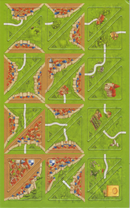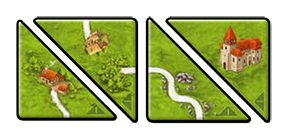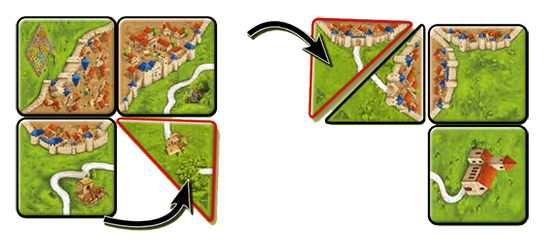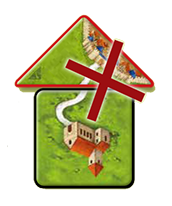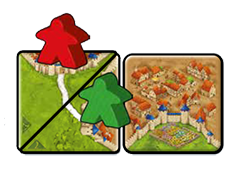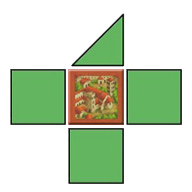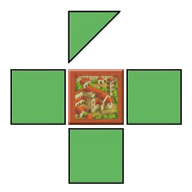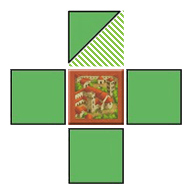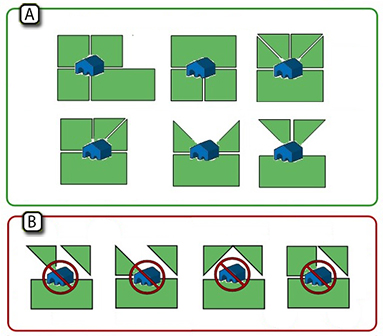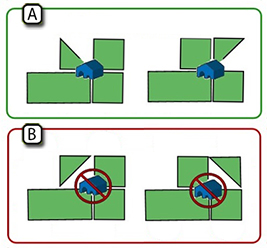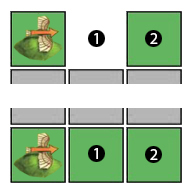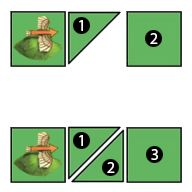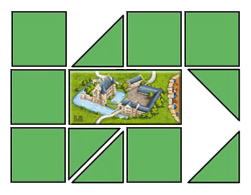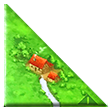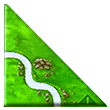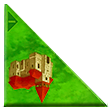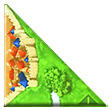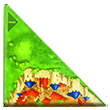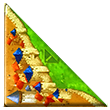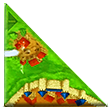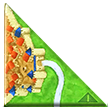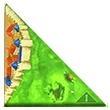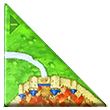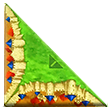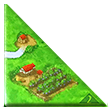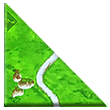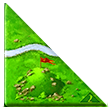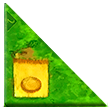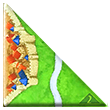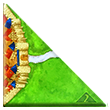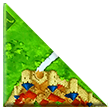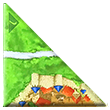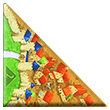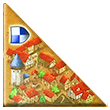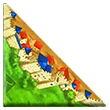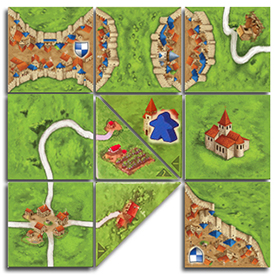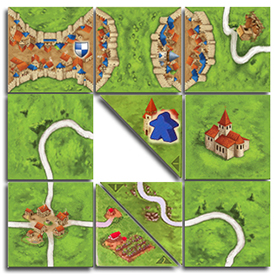Halflingen (Halflings)
Algemene informatie en opmerkingen
File:Symbol C2 Halflings 1.png Halfjes I markering |
File:Symbol C2 Halflings 2.png Halfjes II markering |
Halfjes werd oorspronkelijk in Template:Year nl uitgegeven door Hans im Glück/nl. De 1e editie van deze mini-uitbreiding werd uitgegeven in Template:Year nl.
Deze mini-uitbreiding bevat de tegels van twee mini-uitbreidingen die in 2014 werden uitgegeven. De tegels gemarkeerd met File:Symbol C2 Halflings 1.png komen overeen met de versie die uitgegeven werd door SpielBox magazine (www.spielboxshop.de), de tegels gemarkeerd met File:Symbol C2 Halflings 2.png komen uit een andere versie die oorspronklijk exclusief verkrijgbaar was bij www.cundco.de.
Deze uitbreiding is ontwikkeld voor het Carcassonne basisspel. Alle basisspel regels zijn nog steeds van toepassing naast de onderstaande uitbreidingsregels. Je kunt het combineren met andere uitbreidingen - maar op eigen risico - d.w.z. dat er geen officiële regels zijn voor deze combinaties.
Inhoud
- 24 nieuwe “halfgrote” driehoekige landtegels
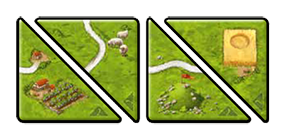
Spelregels
Voorbereiding
Speel je deze uitbreiding voor het eerst, schud dan alle driehoekige tegels (behalve die met symbolen van andere uitbreidingen) gedekt door elkaar. Elke speler trekt 3 driehoekige tegels, bekijkt ze en legt ze gedekt voor zich neer.
Heb je deze uitbreiding al eerder gespeld, dan kun je deze versie spelen: Leg alle driehoekige tegels open op tafel. Bepaal welke speler gaat beginnen. De speler die als laatste aan de beurt is kiest een tegel en legt die gedekt voor zich neer. De rest van de spelers doet, tegen de klok in, hetzelfde totdat iedereen 3 tegels getrokken heeft. De resterende driehoekige tegels gaan terug in de doos. Als je wilt kun je (afhankelijk van het aantal spelers) ook met meer driehoekige tegels spelen.
1. Landtegel leggen
In plaats van een gewone landtegel te trekken en aan te leggen kun je er ook voor kiezen om één van je driehoekige tegels aan te leggen. Het aanleggen van de halfgrote tegels volgt de spelregels van het basisspel van Carcassonne, wat betekent dat tenminste één zijde van de tegel het landschap van het speelveld van bestaande tegels moet voortzetten. De lange zijde van de driehoekige tegel mag nooit langs een normale tegel gelegd worden om het landschap voort te zetten. Je mag een halfgrote tegel echter wel naast een andere halfgrote tegel leggen mits het landschap doorloopt.
Einde van het spel [1]
Het spel eindigt direct aan het einde van de beurt waarin de laatste normale (niet halfgrote) landtegel is gelegd. Als spelers nog ongebruikte halfgrote tegels voor zich hebben liggen, mogen die niet meer aangelegd worden.
2. Een meeple zetten
3. Puntentelling afhandelen
Als je een project met een halfgrote tegel afbouwt, worden de punten volgens de gebruikelijke regels geteld. [4] [5] [6] [7]
Klooster
Een driehoekige tegel die een klooster omringt wordt op dezelfde manier geteld als een normale landtegel (je krijgt er 1 punt voor en hij kan het klooster afbouwen). De driehoekige tegel hoeft niet aan de tegel met het klooster zelf te grenzen om het af te bouwen.
Als er twee driehoekige tegels gelegd zijn in plaats van een normale landtegel, krijg je er toch maar 1 punt voor. [8]
Tegels met symbolen van uitbreidingen
De volgende drie tegels hebben symbolen van de 9e uitbreiding Schapen en Heuvels waarvan de regels van toepassing zijn. De spelregels van tegel 1 en 2 kunnen zonder aanvullend speelmateriaal toegepast worden. Om de schapen op tegel 3 te kunnen gebruiken heb je speelmateriaal nodig dat bij de 9e uitbreiding zit.
1 Wijngaard | Als een klooster wordt afgebouwd en geteld, krijgt de eigenaar 3 punten extra voor elke wijngaard die op de tegels in de omgeving van het klooster (de tegel met het klooster en de 8 vakken daaromheen) staat afgebeeld. [9]
2 Heuvel | Als je de driehoekige tegel met de heuvel wilt aanleggen, trek je volgens de spelregels van de 9e uitbreiding een gewone landtegel en schuift die onder de heuveltegel. De open driehoekige ruimte kan later opgevuld worden door nog een halve tegel te leggen. De heuvel geldt voor het hele vak en dus ook voor een eventuele tweede driehoekige tegel. Als je een meeple hebt op een project met een heuvel, wordt een gelijkspel op dat project bij de puntentelling in jouw voordeel beslist.
3 Schapen | Je krijgt 3 punten voor de schapen op deze tegel als je jouw kudde naar de stal drijft. [10] Een wolf kan deze schapen niet wegjagen. [11]
De tegel waarop de graancirkel staat afgebeeld werkt anders dan de normale graancirkeltegels (zie De Graancirkels).
4 Graancirkel | Met de graancirkeltegel speel je een normale beurt. [12] Daarna bepaal je een soort meeple (ridder, struikrover of boer) en één van de volgende acties die alle spelers (inclusief jijzelf) moet uitvoeren, te beginnen met de speler links van jou:
Iedere speler... [13]
A) ... mag een meeple uit zijn voorraad nemen en die bij een andere eigen meeple van die soort op dezelfde landtegel zetten. [14]
OF
B) ... moet een van zijn eigen meeples van de gekozen soort van een landtegel verwijderen en terug in voorraad nemen.
Als een speler geen meeples van de aangegeven soort heeft, kan hij noch A, noch B uitvoeren.
Gewijzigde spelregels
De spelregels voor de Halfjes zijn een bron van controverse geworden dankzij de vele gaten en conclusies die aan de spelers zijn overgelaten.
De spelregels geven alleen uitleg over het speciale geval van de kloosters. De spelregels uit 2014 vermelden niet eens hoe wegen en steden geteld moeten worden terwijl de spelregels uit 2020 slechts aangeven dat afgebouwde wegen en steden met driehoekige tegels volgens de gebruikelijke spelregels geteld worden.
Het gebrek aan informatie over de telling van wegen en steden leidde in 2014 tot de interpretatie dat ze volgens hetzelfde principe als bij de kloosters vermeld stond geteld moesten worden waarbij twee driehoekige tegels in hetzelfde vierkante vak als één tegel geteld werden. Deze aanname kan gevolgen hebben bij het combineren met andere uitbreidingen aangezien driehoekige tegels in sommige gevallen niet als afzonderlijke tegels gezien zouden worden.
- Puntentelling van projecten met de regels uit 2014:
- Wegen en steden worden geteld op basis van het aantal vierkante tegels (2 driehoekige tegels tellen voor 1 vierkante tegel)
- Kloosters worden geteld op basis van de vierkante vakken met tegels (2 driehoekige tegels tellen voro 1 vierkante tegel) - Kloosters leveren maximaal 9 punten op
De verhelderingen uit 10/2015 werpen meer licht op de puntentelling van steden en wegen (vanaf nu telt elke driehoekige tegel apart mee), maar verandert hoe kloosters geteld moeten worden aangezien elke tegel ook bij kloosters apart mee zou tellen. Een klooster zou dan tot wel 18 punten op kunnen leveren als je zoveel Halfjestegels in de vakken die door het klooster en de 8 omliggende vakken propt. Deze verhelderingen hadden betrekking op de combinatie met sommige andere uitbreidingen, niet allemaal, maar leverden wel hints op om naar analogie ook andere aan te pakken (waar nodig aangevuld met huisregels). Ze zouden behoorlijke gevolgen hebben bij de combinatie met andere uitbreidingen aangezien de driehoekige tegels nu als afzonderlijke tegels gelden. (Dubbele tegels gelden ook als afzonderlijke tegels, waarmee ook aanvullende aanpassing aan de manier waarop sommige uitbreidingen samenwerken nodig was).
- Puntentelling van projecten met de verhelderingen van 10/2015:
- Wegen en steden worden geteld op basis van het aantal afzonderlijke tegels (vierkant, driehoekig of dubbel)
- Kloosters worden geteld op basis van het aantal afzonderlijke tegels (vierkant, driehoekig of dubbel) - Kloosters leveren maximaal 18 punten op
De heruitgave van Halfjes voor Carcassonne II, later in 2020, bevatte spelregels die vergelijkbaar waren met die uit 2014. Er was een korte uitleg hoe wegen en steden geteld moesten worden en de spelregels voor de kloosters deden een stap terug ten opzichte van de verheldering uit 10/2015, terug naar de oorspronkelijke uit 2014. We kunnen aannemen dat de verhelderingen uit 10/2015 nog steeds van toepassing zijn met uitzondering van de telling van kloosters (en derhalve analoog hieraan ook van Duitse burchten).
- Puntentelling van projecten met de spelregels van 2020 + verhelderingen van 10/2015:
- Wegen en steden worden geteld op basis van het aantal afzonderlijke tegels (vierkant, driehoekig, dubbel)
- Kloosters worden geteld op basis van het aantal vierkante vakken met tegels (vierkant, driehoekig of dubbel) - Kloosters leveren maximaal 9 punten op
De volgende tabel geeft een samenvatting van de ontwikkeling van de spelregels en de consequenties daarvan.
| Bijgewerkte spelregels | ||||
|---|---|---|---|---|
| Project | Tegel die een vak bezet | Carcassonne I spelregels uit 2014 | Verhelderingen uit 10/2015 | Carcassonne II spelregels uit 2020 |
| Weg / Stad | Geteld per tegel | Geteld per tegel | Geteld per tegel | |
| 1 vierkante tegel | 1 tegel | 1 tegel | 1 tegel | |
| 1 driehoekige tegel | 1 tegel (1) | 1 tegel | 1 tegel | |
| 2 driehoekige tegel | 2 tegels → geldt als 1 tegel (1) | 2 tegels | 2 tegels | |
| 1 deel van dubbele tegel | n.v.t. (2) | 1 tegel | 1 tegel (3) | |
| Klooster | Tellen per bezet vak | Tellen per tegel | Tellen per bezet vak | |
| 1 vierkante tegel | 1 tegel → 1 bezet vak | 1 tegel | 1 tegel → 1 bezet vak | |
| 1 driehoekige tegel | 1 tegel → 1 bezet vak | 1 tegel (4) | 1 tegel → 1 bezet vak | |
| 2 driehoekige tegels | 2 tegels → 1 bezet vak | 2 tegels (4) | 2 tegels → 1 bezet vak | |
| 1 deel van dubbele tegel | n.v.t. (2) | 1 tegel (4) | 1 tegel → 1 of 2 bezette vakken (5) | |
- Noten:
- (1) Er was geen expliete spelregel. Aangenomen werd dat driehoekige tegels die in hetzelfde vak lagen, net als bij de puntentelling voor kloosters, voor 1 tegel telden. Dit kan het resultaat zijn van een verkeerde interpretatie.
- (2) Dubbele tegels werden pas een jaar later uitgegeven en dus is er in de spelregels van 2014 niet in voorzien.
- (3) Wordt in de spelregels niet behandeld, maar in lijn met de interpretatie van de spelregels van 2020 en de verheldering van 10/2015.
- (4) Driehoekige en dubbele tegels werden bij kloosters als afzonderlijke tegels geteld.
- (5) Wordt in de spelregels niet behandeld, maar deze wijziging komt overeen met het tellen van een klooster per bezet vak uit 2020. Hiermee wordt de verheldering van 10/2015 deels tenietgedaan.
Other expansions
>> General considerations
- When a Halfling tile is beside a triangular gap, the Halfling tile counts as a single tile. When 2 Halfling tiles are side-by-side to create one square, they count as a single tile each. This is relevant when considering city scoring, road scoring, Fairy protection, Dragon movement, the Plague token placement, the Flier movement, etc. (10/2014; updated 10/2015; updated 04/2020)
- Monastery completeness takes into consideration the adjacent spaces: all adjacent of them have to be occupied no matter if by a square a tile or by one or two Halfling tiles. So there may not be a unoccupied adjacent square space.
- Monastery scoring, on the other hand, will not take into consideration individual tiles but occupied spaces (the one of the monastery and all the adjacent spaces). This is a change from the clarifications from 10/2015 and a return to the spirit of the original rules of 2014. This change will also affect the scoring of all those features with mechanics similar to monasteries by extension: all monastic buildings (abbeys, shrines, Japanese buildings, German monasteries, Dutch & Belgian monasteries, Darmstadt churches), gardens and German castles.
- This geometry change in tiles implies a shift and whenever we consider adjacent tiles around a feature, we should consider all the tiles crammed into the adjacent spaces around that feature. This would include, for example, big top scoring, acrobat placement, watchtower scoring, bathhouse completion, the meeple trapping by the Vodyanoy tile, the Baga Yaga's Hut scoring (although it already considered empty spaces), the Darmstadt church bonus, in addition to castle fiefs.
- At present HiG will not provide clarifications about the interactions with for Halflings. Combining Halflings with other expansions will then happen "at the players' own risk." In such cases, house rules will have to be agreed and applied.
>> The Princess & the Dragon - Fairy protection
- There is no official clarification regarding how the fairy behaves when placed on a Halfling tile beyond the general considerations above. As a result, we could consider the fairy only protects the triangular tile it is on, since it is a single tile.
>> The Princess & the Dragon - Dragon movement
- There is no official clarification regarding how the dragon moves on Halfling tiles beyond the general considerations above.
- Notes:
- Rule clarification: When moving the dragon, triangle tiles are considered individual tiles.
- Open question: Can it be assumed that the dragon can move past a triangular gap? Clarifications for other expansions such as The Plague (see below), may lead to a positive conclusion but there is no official confirmation.
>> The Tower - Tower range
- There is no official clarification regarding how tower range is calculated involving Halflings beyond the general considerations above.
- Notes:
- Rule clarification: When computing the tiles affected by the tower range, triangle tiles are counted as individual tiles.
- Open question: Can it be assumed that triangular gaps, if any present, are ignored in the tower range calculation? Clarifications for other expansions such as German monasteries and Japanese Buildings and Dutch and Belgian monasteries (see below), may lead to a positive conclusion but there is no official confirmation.
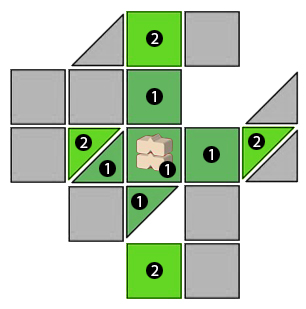 Example: The picture shows the tiles affected by the tower using different shades of green to identify tiles within range 1 and range 2. The range stretch takes into account triangular tiles independently and skips any triangular gap in the way. Skipping triangular gaps is not officially confirmed in an explicit way.
Example: The picture shows the tiles affected by the tower using different shades of green to identify tiles within range 1 and range 2. The range stretch takes into account triangular tiles independently and skips any triangular gap in the way. Skipping triangular gaps is not officially confirmed in an explicit way.
>> Abbey & Mayor - Part 1: Abbey placement and scoring
- An abbey can be placed if a Halfling tile is on one of the edges, even if there is a Halfling gap on one of the edges. See the clarification images below. (3/2015)
- There is no official explicit confirmation on how abbeys are scored when interacting with Halflings beyond ruling for monasteries.
- Notes:
- House rule: The scoring of an abbey follows the official rules defined for monasteries.
>> Abbey & Mayor - Part 2: Barn placement
- A barn can be placed as long as 4 tiles touch at the intersection, even if there is one or more Halfling tiles. (10/2015)
- Additionally the barn placement rules have been updated as follows: The base ground for the barn has to be stable so it cannot wiggle. This means that under the barn:
- all tiles have to touch each other in the middle;
- no quarter is empty in the middle; and
- all tiles have farm in the middle for the placement of the barn.
- See the following examples involving Halfling tiles and double-size tiles (see Castles in Germany and The Markets of Leipzig.) (04/2016)
- Note: The rules update from 10/2015 overrides, in certain cases, the original four-tile intersection requirement for the placement of the barn defined originally for square tiles. This happens in favor of providing stability to the barn when tiles with other geometries are considered, as can be seen in the examples involving double-size tiles and/or triangle tiles.
>> Abbey & Mayor - Part 3: Barn scoring
- There is no official rules on how barns interact with the landscape discontinuities that can be generated by Halflings.
- Notes:
- Open question: Can triangular gaps be considered as holes in the farm landscape? If so, certain tile configuration could lead to the creation of separate farms that converge at an intersection, some of them eligible for barn placement. There is no official rule or clarification stating how triangle gaps affect farms.
- Open question: When placed on a farm convergence intersection, does the barn connect these separate farms to form one single farm? There is no official rule or clarification on this point, but the official rules for barn placement were designed to ensure it was always placed on one single farm.
- House rule 1: Triangular gaps could be considered as limits of the landscape (the same as square holes), so several farms can converge at a tile intersection and be disconnected.
- House rule 2: The barn, when placed (legally) at a point where several farms meet, they should be considered as merged into one single farm. This seems reasonable as the placement of additional Halfling tiles filling the gaps would not alter the previous situation but resolve to materialize the assumed landscape continuity. Additionally, all the barn scoring rules would apply as usual.
>> Count, King and Robber - Shrine scoring
- There is no official explicit confirmation on how shrines are scored when interacting with Halflings beyond ruling for monasteries.
- Notes:
- House rule: The scoring of a shrine follows the official rules defined for monasteries.
>> Bridges, Castles and Bazaars - Bridge placement
- There is no official clarification regarding how bridges can interact with Halflings.
- Notes:
- Open question: Can a bridge be placed on a square space only occupied by one to two Halflings?
- House rule: A house rule could allow the placement of the bridge only if it stands on a stable base ground following the lead of the clarifications for the Abbey & Mayor's barn (see above). This would mean that bridges could be deployed on a place occupied by a square tile or two Halflings, but not if occupied by one single Halfling.
>> The Flier (Flying Machines) - Flier distance and placement
- There is no official clarification regarding how the Flier distance and landing cases are handled when Halflings are involved beyond the general considerations above.
- Notes:
- Rule clarification: When computing the Flier distance, triangle tiles are counted as individual tiles.
- Open question: Can it be assumed that triangular gaps, if any present, are ignored and only the Halfling tiles are taken into account for computing the Flier distance? Clarifications for other expansions such as German/Dutch and Belgian Monasteries (see below), may lead to a positive conclusion but there is no official confirmation. See the examples below following this assumption.
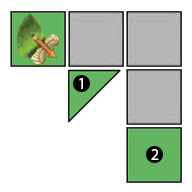
- Open question: How to proceed if the Flier, following a diagonal trajectory, has to land on a square space occupied by two triangle tiles whose long side is aligned with such trajectory? No official clarification exists. A house rule may dictate that the player may choose a feature of either tile.
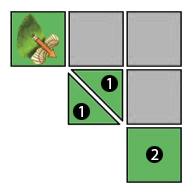 Example 5: This image shows how triangle tiles are considered when calculating the Flier distance for a diagonal trajectory. This particular case, due to the orientation of the Halflings, has two possible tiles with distance 1. A house rule could determine that if a Flier had to land with such a distance, he/she could choose either of them as the landing tile.
Example 5: This image shows how triangle tiles are considered when calculating the Flier distance for a diagonal trajectory. This particular case, due to the orientation of the Halflings, has two possible tiles with distance 1. A house rule could determine that if a Flier had to land with such a distance, he/she could choose either of them as the landing tile.
- House rule: A house rule could define that the Flier distance is calculated taking into account square tiles, square gaps and triangular tiles. If the landing place contains two triangular tiles with the same distance, the player will choose either of them at his/her convenience.
>> The Plague - Plague spreading
- A single triangle hole does not prevent the Plague from spreading in that direction. (10/2015)
>> German monasteries and Japanese buildings / German/Dutch and Belgian monasteries - Abbot scoring
- A triangle tile takes the place of a regular landscape tile. Thus, a single triangle hole in the map does not stop the row or column for scoring for German and Dutch/Belgian Monasteries's abbot. Only a hole of a complete regular landscape tile interrupts the row or column. (3/2015)
- The following image shows how triangle tiles are considered individually when scoring an abbot placed on a German Monastery. It can be seen that triangular gaps are ignored.
 Example: RED will get 1 + 2 + 2 + 3 + 1 = 9 points from scoring his/her abbot:
Example: RED will get 1 + 2 + 2 + 3 + 1 = 9 points from scoring his/her abbot:- 1 point from the monastery tile
- 2 points from the vertical column above the monastery tile (1 point coming from a triangular tile)
- 2 points from the vertical column below the monastery tile (1 point coming from a triangular tile)
- 3 points from the horizontal row to the left of the monastery tile (2 points coming from triangular tiles)
- 1 point from the horizontal row to the right of the monastery tile formed by a single triangular tile
>> Castles in Germany - Completion of German Castles
- There is no official clarification regarding how German Castles interact with Halflings beyond the general considerations above.
- Note:
- House rule: A German Castle could be considered completed if totally surrounded by square tiles and spaces occupied by one or two Halflings, following the official ruling for monasteries.
- House rule: The scoring of a German Castle could be 2 points for the German Castle tile plus 1 point per surrounding occupied space (no matter if by square or triangular tiles), taking into account the official rules for monasteries.
>> Little Buldings - Area affected by Little Building
- There is no official clarification regarding how Little Buildings interact with Halflings beyond the general considerations above.
- Note:
- House rule: A Little Building only affects the Halfling tile it is placed on, not affecting the other Halfling, if any, sharing the same square space. This consideration comes from the fact that a Halfling counts as a single tile and Little Building affects a whole tile.
Community rules
>> Introduction
This section provides a set basic unofficial community rules to navigate through the pitfalls found when playing Halflings. They are not official but will help solve some of the issues derived from the lack of rules for the expansion itself and the interactions with other expansions.
The Carcassonne base rules define the behavior and interactions based on a square grid occupied by tiles and holes. The problems with Halflings arise from the lack of a full set of rules that cover all the cases when a square space is occupied by a triangular tile (that leaves a triangular gap) or two triangular tiles.
Triangular tiles are considered as individual tiles, and this affects several aspects of the basic game mechanics. However, triangular gaps become a serious generator of continuous conflict. The incomplete clarifications to the Halflings rules leave behind a field full of pitfalls and a few hints that players try to squeeze and analyze looking for answers that will never be officially confirmed by HiG.
With this context, after detailing in the previous section the rules, clarifications, open questions and some house rules for the interactions between Halflings and other expansions, we'll try to put together some basic remarks that could serve as a short guideline that distill the aforementioned material.
>> Rationale
Two principles serve as a cornerstone:
- Triangular tiles are counted as individual tiles
- Triangular gaps show two different behaviors depending on the context:
- A triangular gap can behave as a hole, for example, in a feature
- A triangular gap can be ignored, for example, when moving a figure
The table below sums up the different contexts where issues arise and provide an appropriate ruling. But first let's list the game contexts taken into consideration:
- Landscape Continuity: how triangular tiles and gaps affect various features, such as a farm or a city
- Feature Placement: how triangular tiles and gaps affect the placement of a feature, such as an abbey
- Feature Completeness: how triangular tiles and gaps affect a feature to be considered as completed, such as a city or a monastery
- Featuring Scoring: how triangular tiles and gaps affect the scoring of a feature, such as a monastery (which ignore them)
- Figure Placing/Movement: how figure mechanics are affected by triangular tiles and gaps; for example, the dragon
- Action Range / Trajectory calculation: how action ranges for a tower or the trajectory of a flier are affected by triangular tiles and gaps
>> How to deal with triangular tiles and gaps
Important Reminder: Triangular tiles are considered as individual tiles. Bear this in mind when placing followers or other figures, and when scoring features.
The following table summarizes the community rules for conflicting scenarios.
| Triangular Tiles and Triangular Gap Behavior | ||||||
|---|---|---|---|---|---|---|
| Gap Behavior | Landscape Continuity | Feature Placement | Feature Completeness | Feature Scoring | Placing / Moving a Figure | Action range / Trajectory Calculation |
| A hole | Farm (1) | Farm | Bridge | |||
| City, Road | City, Road | City, Road | ||||
| Ignored | Abbey (2) | Monastery, Shrine, Abbey, Garden, German monastery / Dutch & Belgian monastery / Japanese building (monk), Darmstadt church, German castle | Monastery, Shrine, Abbey, Garden, German monastery / Dutch & Belgian monastery / Japanese building (monk), Darmstadt church, German castle (3) | Dragon | Tower, Flier (4) | |
| German monastery / Dutch & Belgian monastery / Japanese building (abbot) | ||||||
| Flea Token | ||||||
- Notes:
- (1) - Farm continuity: The placement of a barn can alter farm continuity if it merges separate farms touching at intersection it is placed on.
- (2) - Abbey placement: An eligible place for an abbey requires its four sides not to be square holes.
- (3) - Monastery (and analogous features) scoring: these features ignore triangular gaps and score according to occupied spaces (the one for the feature and the adjacent ones). Spaces can be occupied by square tiles, one triangular tile, two triangular tile to by part of a double-sized tile, by extension.
- (4) - Flier landing: if the Flier has to land on a square space with two triangular tiles side by side when following a diagonal trajectory (i.e., both share the same distance), the player has to choose one of them at his/her convenience as landing tile.
>> How to deal with the barn
Additionally, these are the community rules for the barn:
- Placement Rules: It is placed on the intersection of four square corners where all quarters are partially or fully occupied and meet in the middle. That is, the barn is always placed on a stable base ground. At an intersection can meet from 3 (involving a double-sized tile) up to 8 tiles (all of them Halflings), and all of them should have only farmland to allow the barn to be placed.
- Landscape Continuity: The barn will merge any farms touching at the intersection where it is placed. Thus, farm scoring will happen as usual. Any additional triangular tile placed in any gaps left under the barn will materialize the assumed farm continuity.
>> How to deal with Little Buildings
Little Buildings placed on a Halfling tile will affect only that triangular tile. If another Halfling tile shares the same square space, it will not be affected. [15]
Tile distribution
Total Tiles: 24 halves
Halflings I
Total Tiles: 12 halves
Halflings II
Total Tiles: 12 halves
Footnotes
For Icons explanation and licensing please visit Icons page.
- ↑
 Dit gedeelte stond wel in de spelregels uit 2014 maar is in de spelregels van 2020 weggelaten.
Dit gedeelte stond wel in de spelregels uit 2014 maar is in de spelregels van 2020 weggelaten.
- ↑
 Deze zin is een vertaling van de Duitse spelregels. De Engelse vertaling van HiG had een afwijkende betekenis, waarschijnlijk een vergissing: "Je mag ook een meeple op een aangrenzende driehoekige tegel zetten als er al een staat."
Deze zin is een vertaling van de Duitse spelregels. De Engelse vertaling van HiG had een afwijkende betekenis, waarschijnlijk een vergissing: "Je mag ook een meeple op een aangrenzende driehoekige tegel zetten als er al een staat."
- ↑
 Deze opmerking geeft aan dat driehoekige tegels onafhankelijk zijn, ook al bevinden ze zich in dezelfde vierkante ruimte.
Deze opmerking geeft aan dat driehoekige tegels onafhankelijk zijn, ook al bevinden ze zich in dezelfde vierkante ruimte.
- ↑
 Deze zin is gebaseerd op de Duitse bewoording. De Engelse versie heeft een andere betekenis, mogelijk door een vergissing: "Als je een project afbouwt door een halfgrote tegel te leggen, worden de punten volgens de spelregels van het basisspel geteld."
Deze zin is gebaseerd op de Duitse bewoording. De Engelse versie heeft een andere betekenis, mogelijk door een vergissing: "Als je een project afbouwt door een halfgrote tegel te leggen, worden de punten volgens de spelregels van het basisspel geteld."
- ↑
 Volgens de spelregels van het basisspel, mogen afgebouwde steden geen gaten bevatten. In dit geval betekent dit dat ze noch vierkante, noch driehoekige gaten mogen bevatten. Wegen volgen dezelfde regels: een weg met een driehoekig gat wordt ook als niet afgebouwd beschouwd.
Volgens de spelregels van het basisspel, mogen afgebouwde steden geen gaten bevatten. In dit geval betekent dit dat ze noch vierkante, noch driehoekige gaten mogen bevatten. Wegen volgen dezelfde regels: een weg met een driehoekig gat wordt ook als niet afgebouwd beschouwd.
- ↑
 Het tellen van een afgebouwde stad of weg volgt de gebruikelijke spelregels en elke driehoekige tegel telt mee als een normale tegel.
Het tellen van een afgebouwde stad of weg volgt de gebruikelijke spelregels en elke driehoekige tegel telt mee als een normale tegel.
- ↑
 De puntentelling voor weiden wordt beïnvloed door de driehoekige gaten in het speelveld. Dit staat niet expliciet in de spelregels of latere verhelderingen. Als we echter het principe toepassen dat andere projecten dan kloosters volgens de gebruikelijke spelregels geteld worden, dan worden weiden onderbroken door driehoekige gaten en komen ze neer op een grens.
De puntentelling voor weiden wordt beïnvloed door de driehoekige gaten in het speelveld. Dit staat niet expliciet in de spelregels of latere verhelderingen. Als we echter het principe toepassen dat andere projecten dan kloosters volgens de gebruikelijke spelregels geteld worden, dan worden weiden onderbroken door driehoekige gaten en komen ze neer op een grens.
- ↑
 Kloosters krijgen derhalve punten voor de vierkante ruimtes die door het klooster zelf en door tegels (1 of 2) in omringende ruimtes bezet worden. Het aantal tegels op deze ruimtes maakt niet uit. Dit betekent dat:
Kloosters krijgen derhalve punten voor de vierkante ruimtes die door het klooster zelf en door tegels (1 of 2) in omringende ruimtes bezet worden. Het aantal tegels op deze ruimtes maakt niet uit. Dit betekent dat:
- Je tijdens het spel altijd 9 punten krijgt voor een afgebouwd klooster.
- Je voor een onafgebouwd klooster aan het einde van het spel 1 punt krijgt voor de ruimte met de kloostertegel en 1 punt voor elke omringende ruimte met een tegel.
 Voorbeeld van een eindtelling: Blauw krijgt 6 punten voor diens klooster:
Voorbeeld van een eindtelling: Blauw krijgt 6 punten voor diens klooster:- 1 punt voor het vak waar het klooster ligt, zelfs als hier twee driehoekige tegels liggen.
- 1 punt voor elk omringend vak waar vierkante tegels liggen.
- 1 punt voor het vak waar het klooster ligt.
- 1 punt voor elk bezet omringend vak ongeacht of er 1 of 2 driehoekige tegels of een vierkante tegel ligt.
- ↑
 De bewoording is aangepast om de gevallen te omvatten die onstaan zijn door de introductie van de Halfjes. In de oorspronkelijke bewoording wordt alleen gesproken van de 8 omliggende tegels, waarmee alleen spelregels voor vierkante tegels worden aangenomen: "Als een klooster wordt afgebouwd en geteld, krijgt de eigenaar 3 punten extra voor elke wijngaard die op de 8 tegels die het klooster omringen staat afgebeeld." Met de Halfjes kunen er wel 16 aangrenzende tegels zijn. Bovendien, aangezien er ook een halve tegel is met een klooster en één met met een wijngaard die in hetzelfde vak gelegd kunnen worden, kan een wijngaard zich niet alleen tegels in de omliggende vakken bevinden, maar ook op een tegel in hetzelfde vak als het klooster. De spelregels dienen met al deze gevallen rekening te houden.
De bewoording is aangepast om de gevallen te omvatten die onstaan zijn door de introductie van de Halfjes. In de oorspronkelijke bewoording wordt alleen gesproken van de 8 omliggende tegels, waarmee alleen spelregels voor vierkante tegels worden aangenomen: "Als een klooster wordt afgebouwd en geteld, krijgt de eigenaar 3 punten extra voor elke wijngaard die op de 8 tegels die het klooster omringen staat afgebeeld." Met de Halfjes kunen er wel 16 aangrenzende tegels zijn. Bovendien, aangezien er ook een halve tegel is met een klooster en één met met een wijngaard die in hetzelfde vak gelegd kunnen worden, kan een wijngaard zich niet alleen tegels in de omliggende vakken bevinden, maar ook op een tegel in hetzelfde vak als het klooster. De spelregels dienen met al deze gevallen rekening te houden.
- ↑
 De schapen op de tegel tellen elke keer dat een herder op de betreffende weide zijn schapen telt mee als "permanente" schaapsfiches. (11/2014)
De schapen op de tegel tellen elke keer dat een herder op de betreffende weide zijn schapen telt mee als "permanente" schaapsfiches. (11/2014)
- ↑
 We vervangen deze zin met een vertaling uit de Duitse versie. De Engelse bewoording is wat misleidend: "Een wolf kan je kudde niet uiteenjagen."
We vervangen deze zin met een vertaling uit de Duitse versie. De Engelse bewoording is wat misleidend: "Een wolf kan je kudde niet uiteenjagen."
- ↑
 Voor de duidelijkheid gebruiken we een vertaling van de Duitse spelregels. De Engelse bewoording is als volgt: "Leg de driehoekige graancirkeltegel volgens de spelregels aan."
Voor de duidelijkheid gebruiken we een vertaling van de Duitse spelregels. De Engelse bewoording is als volgt: "Leg de driehoekige graancirkeltegel volgens de spelregels aan."
- ↑
 We hebben een vertaling van de Duitse spelregels gebruikt. De Engelse spelregels bevatten een foutieve vertaling waarin staat:
We hebben een vertaling van de Duitse spelregels gebruikt. De Engelse spelregels bevatten een foutieve vertaling waarin staat:
"Iedere speler moet ofwel ...
A) ... een meeple uit zijn voorraad nemen en die naast een andere eigen meeple van deze soort op dezelfde landtegel zetten.
OFWEL
B) ... een van zijn eigen meeples van de gekozen soort van een landtegel verwijderen en terug in voorraad nemen." - ↑
 De meeple moet bij een eigen meeple, dus op hetzelfde project op dezelfde tegel, gezet worden.
De meeple moet bij een eigen meeple, dus op hetzelfde project op dezelfde tegel, gezet worden.
- ↑
 According to the interpretation of the rules from 2014, a Little Building on a Halfling tile would have affected both triangular tiles sharing the same square space, since they are counted as one single tile for scoring.
According to the interpretation of the rules from 2014, a Little Building on a Halfling tile would have affected both triangular tiles sharing the same square space, since they are counted as one single tile for scoring.
- Editor Manual - Old numbered parameters - RulesPlacingTile
- Editor Manual - Old numbered parameters - RulesPlacingMeeple
- Editor Manual - Old numbered parameters - RulesScoring
- Editor Manual - Old numbered parameters - Tile
- Old template
- Old template - FootnoteIconPara en
- Second Edition
- Second Edition Minor Expansion

